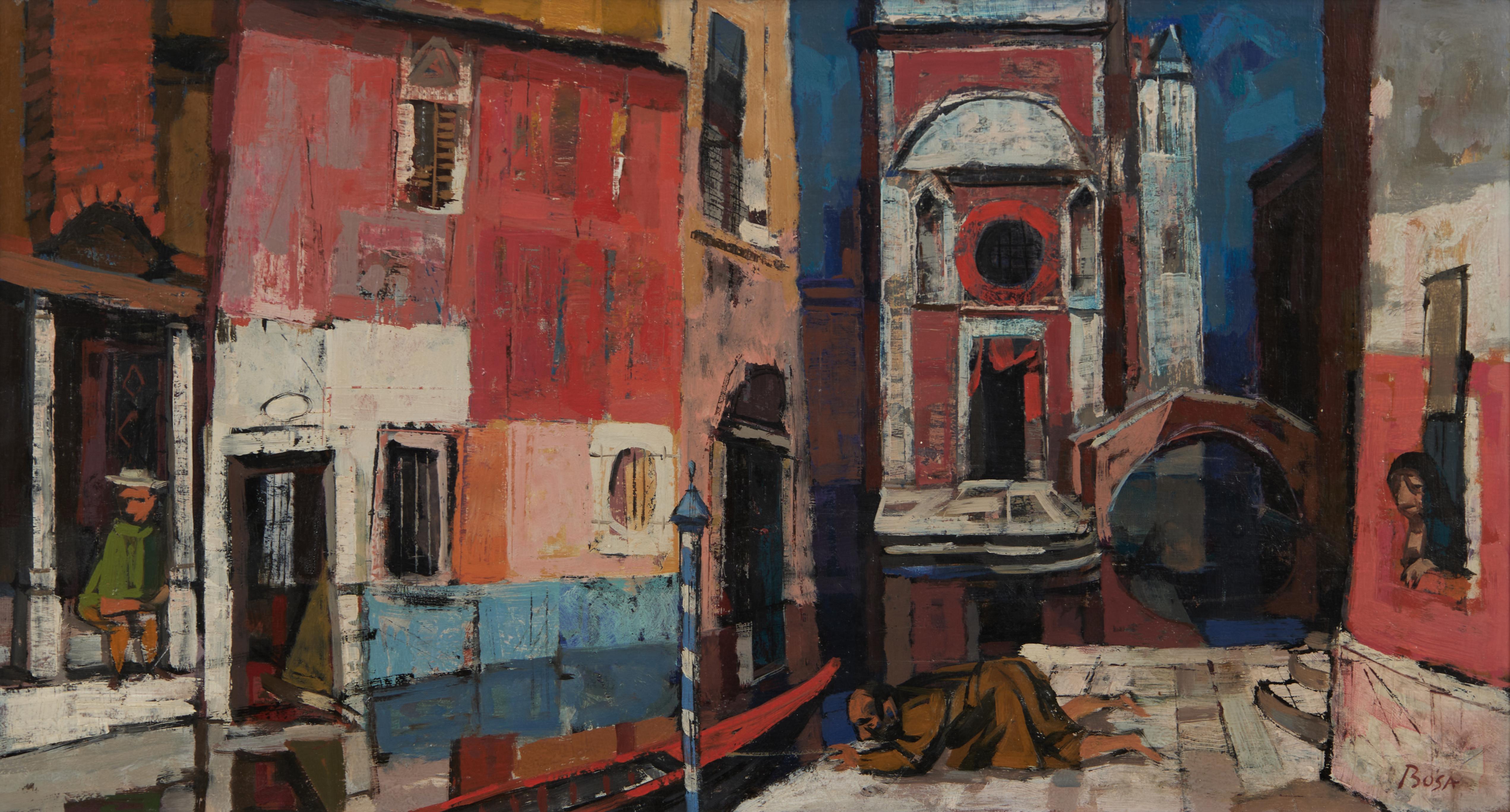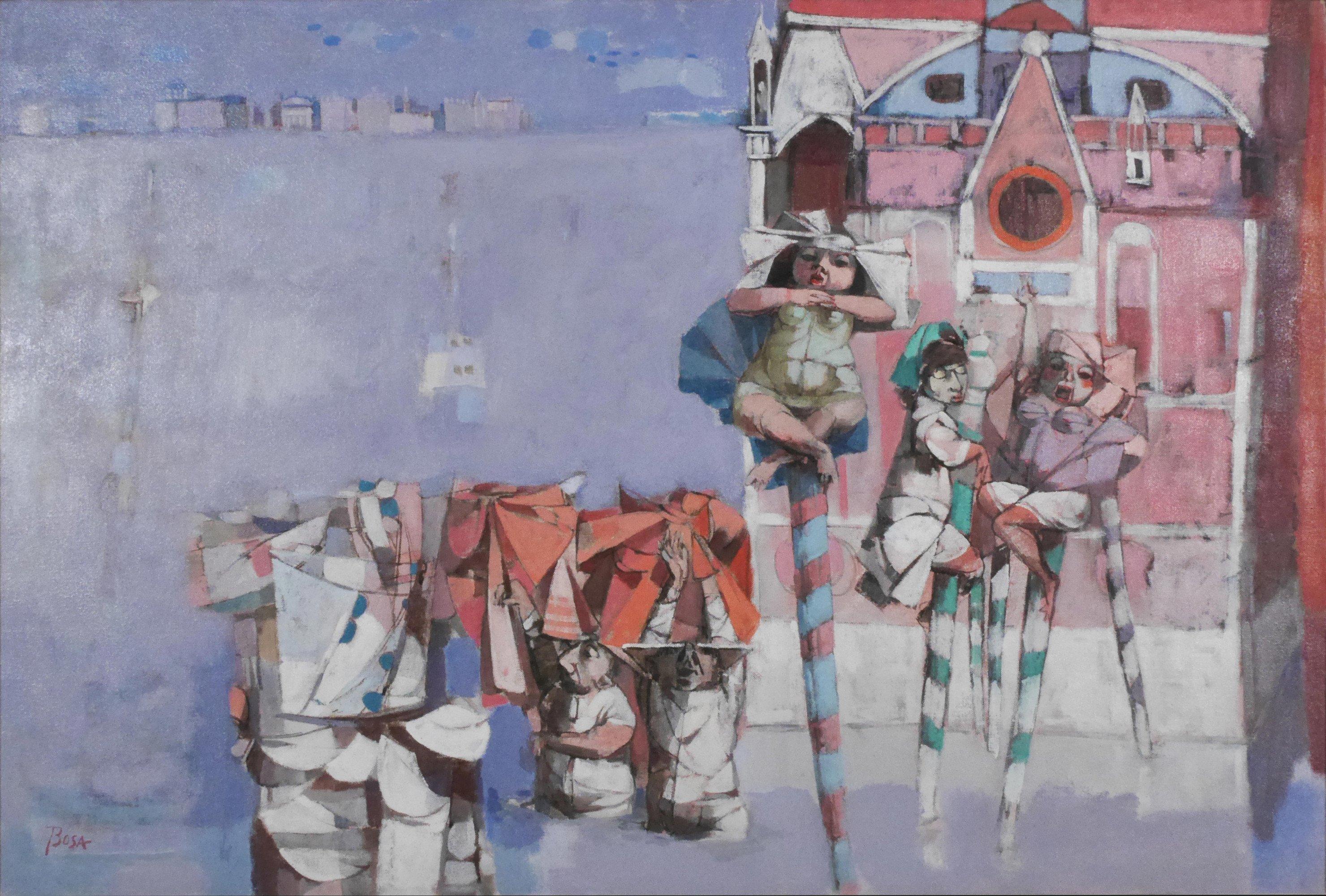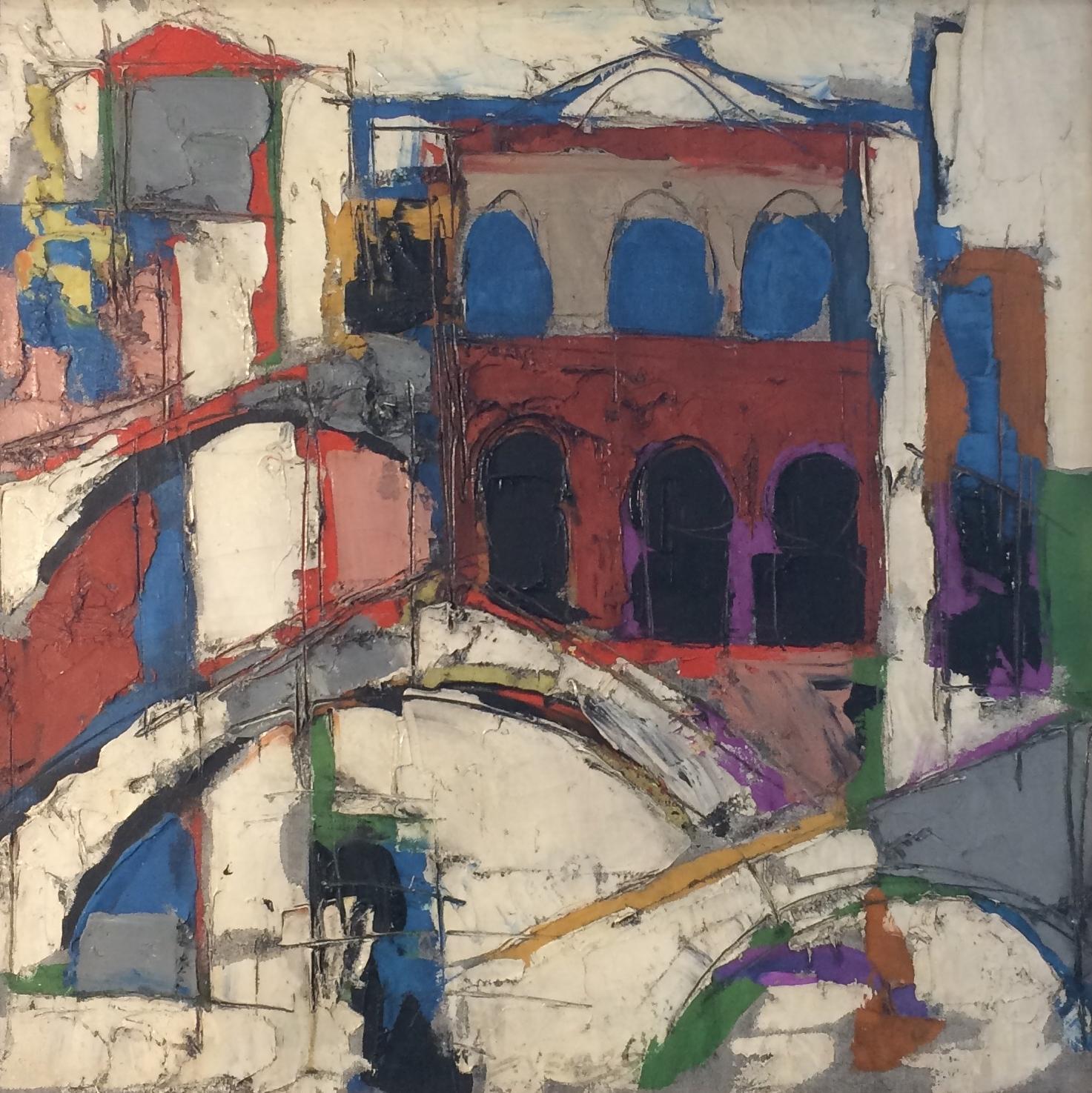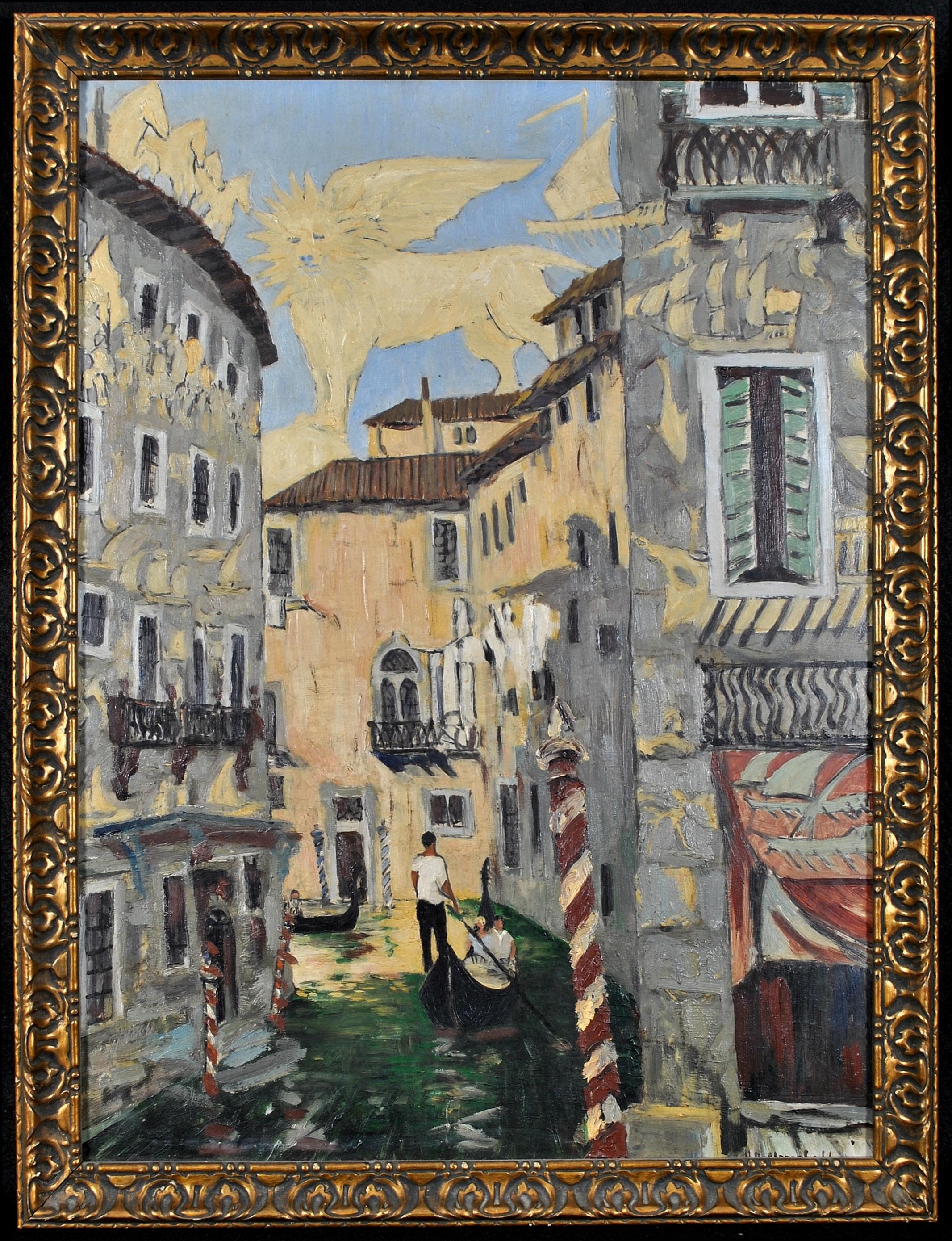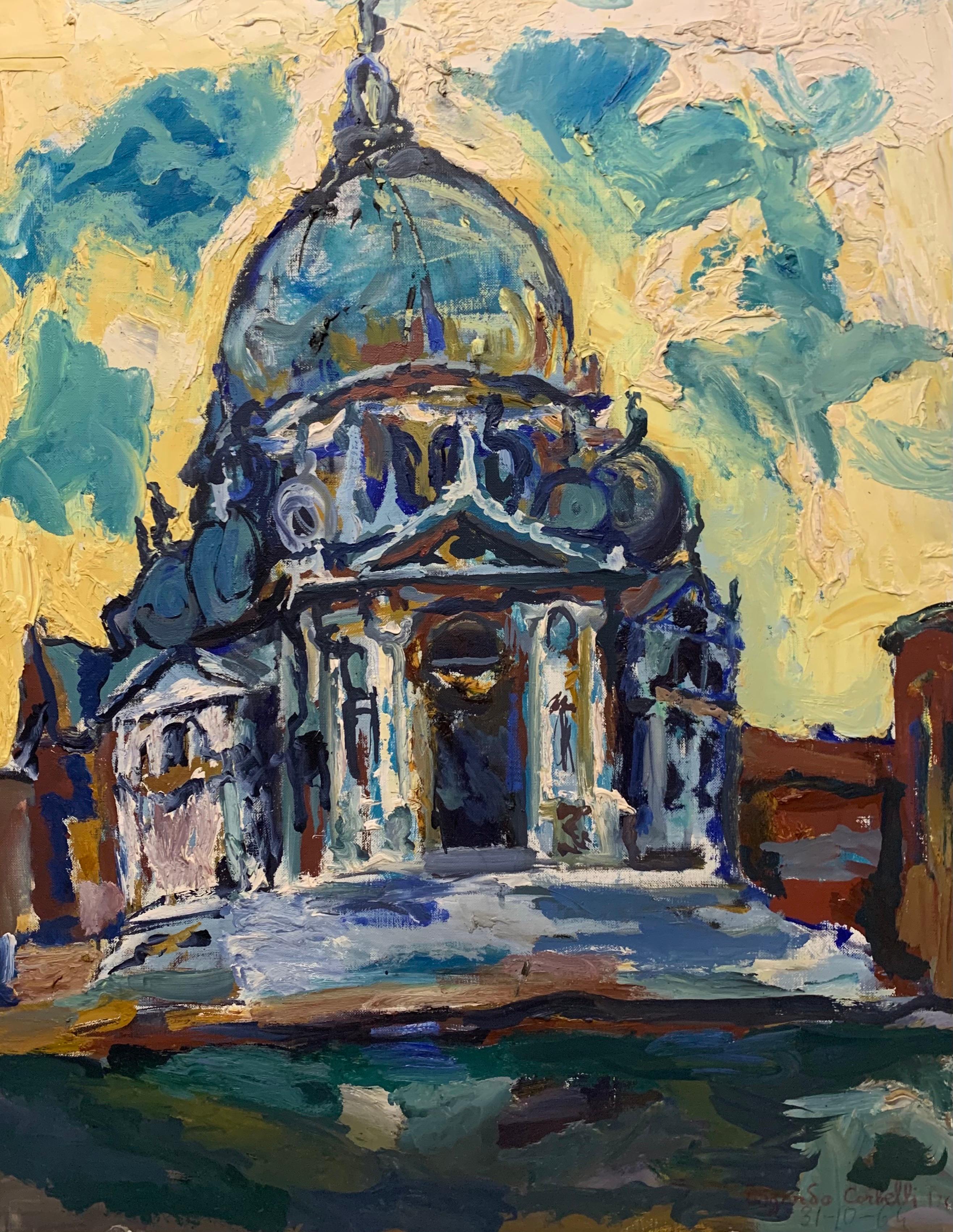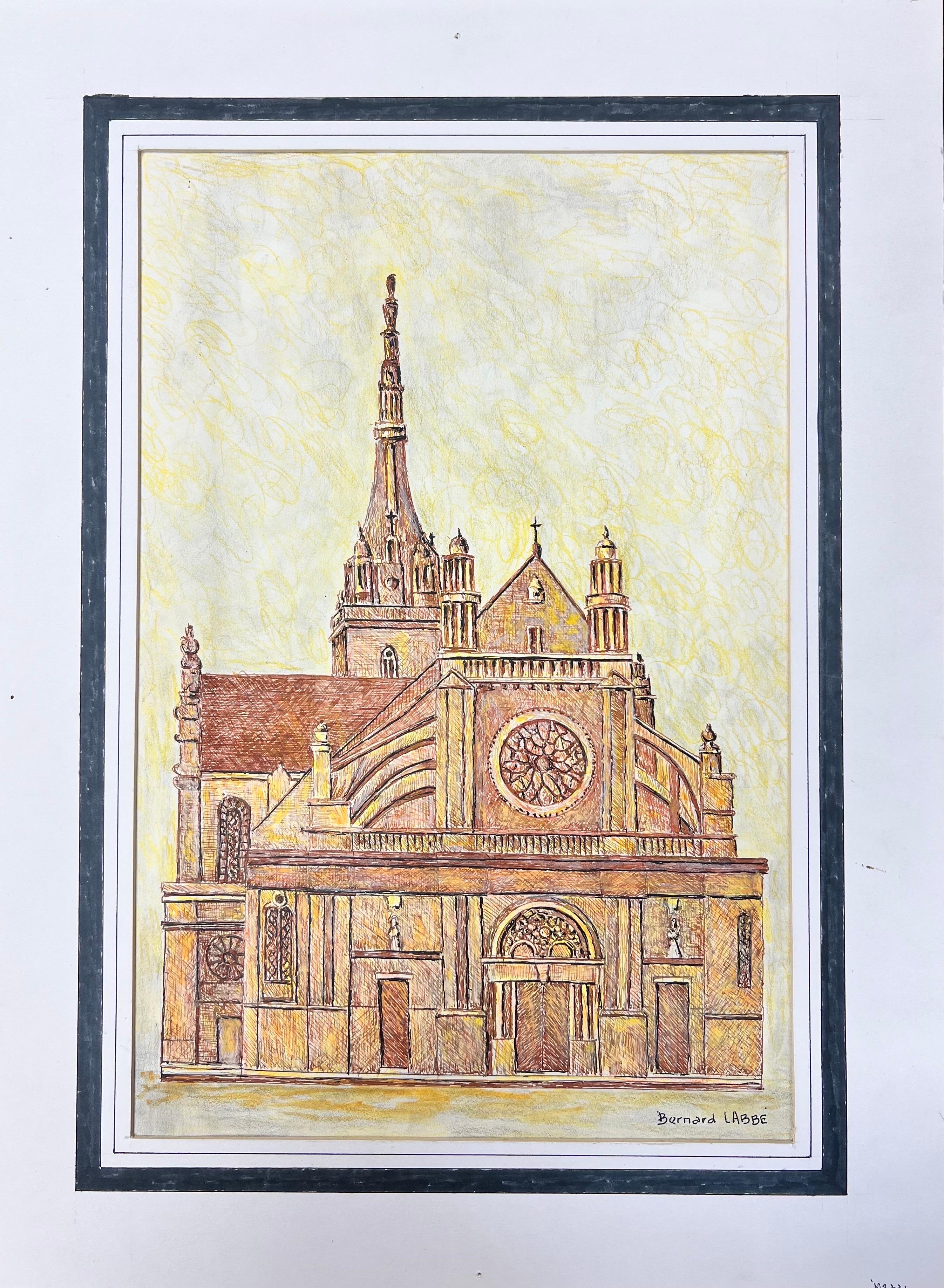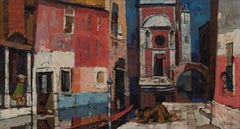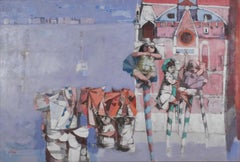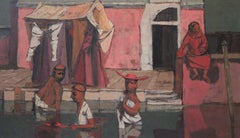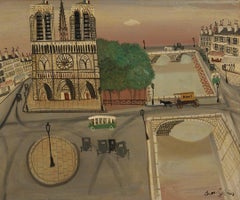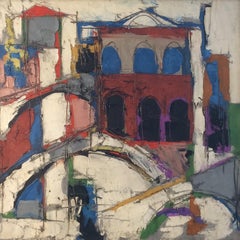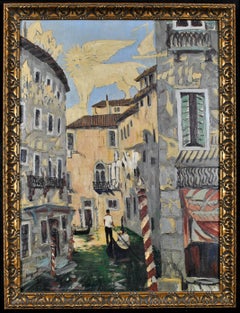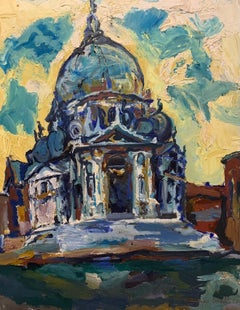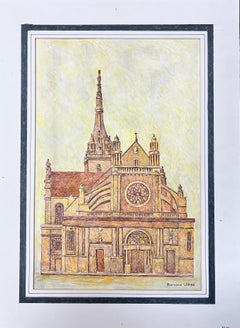Items Similar to Cathedral in Venice, large 20th century oil painting, Italian-American artist
Video Loading
Want more images or videos?
Request additional images or videos from the seller
1 of 16
Louis BosaCathedral in Venice, large 20th century oil painting, Italian-American artist
$5,500
£4,173.27
€4,771.77
CA$7,682.01
A$8,541.35
CHF 4,459.82
MX$103,969.01
NOK 56,905.37
SEK 53,317.61
DKK 35,612.56
Shipping
Retrieving quote...The 1stDibs Promise:
Authenticity Guarantee,
Money-Back Guarantee,
24-Hour Cancellation
About the Item
Louis Bosa (American, 1905-1981)
Cathedral in Venice
Oil on canvas
Signed lower left
60.25 x 40.25 inches
66.5 x 46.5 inches, framed
Born in Codroipo, a small village only a few miles from Venice, Italy in 1905, the son of a stonemason. Bosa emigrated to the U.S. at age 18 after studies at the Accademia della Belle Arti in Venice and became an American citizen. He then studied under John Sloan, of the Ashcan School, at the Art Students League in New York. A distinguished painter, Louis Bosa's work has been likened to that of artists ranging from Pieter Breughel the Elder to John Sloan and the Ashcan School.
Being an acute observer of the human condition, Bosa's paintings, which are primarily oil on canvas, often focus on people and street scenes from his native Italy. Bosa was known to have followed his subjects around, making many sketches and mental notes, and combined his observations in the final work to create visionary, fantastical images. The subjects of his paintings are highly stylized and expressionistic, and border on caricature. "People are so funny at times they are sad," he said: The people in his paintings are accessible and seem to portray human emotion and everyday life, conquering such concepts as mortality, humility and sometimes futility. His work often reveals comedy in the midst of tragedy. Many of his paintings include whimsical images of nuns riding bicycles and similar authority figures engaged in mundane activities.
He traveled extensively through Europe and often returned to his native Italy. Bosa painted for the Works Progress Administration and the Whitney Museum. He taught at the Cleveland Institute of Art, the New York Art Students League, the Parsons School of Design, Syracuse University, and the University of Notre Dame at South Bend, Indiana. His paintings and watercolors are on display at many well-known art studios and museums across the United States such as:
The Metropolitan Museum of Art - New York
The Whitney Museum - New York
The Philadelphia Museum - Pennsylvania
The Worcester Museum - Massachusetts
The Springfield Museum - Massachusetts
The Toronto Art Museum - Canada
Notre Dame University Museum
The Butler Museum - Ohio
The Columbus Museum of Arts and Crafts - Ohio
The University of Illinois - Illinois
The Montclair Museum - New Jersey
The James A. Michener Art Museum - Doylestown, Pennsylvania
The Clearwater Museum - Florida
The Wilmington Museum - Delaware
The Athenian Museum - Connecticut
The Herron Art Institute - Indiana
The Rochester Museum - New York
The Delgado Museum - New Orleans
The Richmond Art Museum - Virginia
The Academy of Arts and Letters
The Hosanna Fund
The Encyclopedia Britannica Collections
International Business Machines
The Syracuse Museum - New York
- Creator:Louis Bosa (1905-1981, Italian)
- Dimensions:Height: 60.25 in (153.04 cm)Width: 40.25 in (102.24 cm)
- Medium:
- Movement & Style:
- Period:
- Condition:
- Gallery Location:Beachwood, OH
- Reference Number:1stDibs: LU1768213888292
Louis Bosa
Born in Codroipo, a small village only a few miles from Venice, Italy in 1905, the son of a stonemason. Bosa emigrated to the U.S. at age 18 after studies at the Accademia della Belle Arti in Venice and became an American citizen. He then studied under John Sloan, of the Ashcan School, at the Art Students League in New York. A distinguished painter, Louis Bosa's work has been likened to that of artists ranging from Pieter Breughel the Elder to John Sloan and the Ashcan School. Being an acute observer of the human condition, Bosa's paintings, which are primarily oil on canvas, often focus on people and street scenes from his native Italy. Bosa was known to have followed his subjects around, making many sketches and mental notes, and combined his observations in the final work to create visionary, fantastical images. The subjects of his paintings are highly stylized and expressionistic, and border on caricature. "People are so funny at times they are sad," he said: The people in his paintings are accessible and seem to portray human emotion and everyday life, conquering such concepts as mortality, humility and sometimes futility. His work often reveals comedy in the midst of tragedy. Many of his paintings include whimsical images of nuns riding bicycles and similar authority figures engaged in mundane activities. He traveled extensively through Europe and often returned to his native Italy. Bosa painted for the Works Progress Administration and the Whitney Museum. He taught at the Cleveland Institute of Art, the New York Art Students League, the Parsons School of Design, Syracuse University, and the University of Notre Dame at South Bend, Indiana. His paintings and watercolors are on display at many well-known art studios and museums across the United States such as: The Metropolitan Museum of Art - New York The Whitney Museum - New York
The Philadelphia Museum - Pennsylvania
The Worcester Museum - Massachusetts
The Springfield Museum - Massachusetts
The Toronto Art Museum - Canada
Notre Dame University Museum
The Butler Museum - Ohio
The Columbus Museum of Arts and Crafts - Ohio
The University of Illinois - Illinois
The Montclair Museum - New Jersey
The James A. Michener Art Museum - Doylestown, Pennsylvania
The Clearwater Museum - Florida
The Wilmington Museum - Delaware
The Athenian Museum - Connecticut
The Herron Art Institute - Indiana
The Rochester Museum - New York
The Delgado Museum - New Orleans
The Richmond Art Museum - Virginia
The Academy of Arts and Letters
The Hosanna Fund
The Encyclopedia Britannica Collections
International Business Machines
The Syracuse Museum - New York
About the Seller
5.0
Vetted Professional Seller
Every seller passes strict standards for authenticity and reliability
Established in 1975
1stDibs seller since 2022
34 sales on 1stDibs
Typical response time: 1 hour
- ShippingRetrieving quote...Shipping from: Beachwood, OH
- Return Policy
Authenticity Guarantee
In the unlikely event there’s an issue with an item’s authenticity, contact us within 1 year for a full refund. DetailsMoney-Back Guarantee
If your item is not as described, is damaged in transit, or does not arrive, contact us within 7 days for a full refund. Details24-Hour Cancellation
You have a 24-hour grace period in which to reconsider your purchase, with no questions asked.Vetted Professional Sellers
Our world-class sellers must adhere to strict standards for service and quality, maintaining the integrity of our listings.Price-Match Guarantee
If you find that a seller listed the same item for a lower price elsewhere, we’ll match it.Trusted Global Delivery
Our best-in-class carrier network provides specialized shipping options worldwide, including custom delivery.More From This Seller
View AllMid-20th Century Venetian Canal Cityscape, Italian-American artist
By Louis Bosa
Located in Beachwood, OH
Louis Bosa (American, 1905-1981)
Venice Canalscape, c. 1950
Oil on board
Signed lower right
11.75 x 21.75 inches
19.75 x 29.75 inches, framed
Born in Codroipo, a small village only ...
Category
1950s American Modern Figurative Paintings
Materials
Oil
Flood in Venice, Italian Artist, Humorous Landscape/Seascape Scene
By Louis Bosa
Located in Beachwood, OH
Louis Bosa (American, 1905-1981)
Flood in Venice, c. 1970
Oil on canvas
Signed Bosa lower left and verso
34 x 50.5 inches
40.5 x 56.5 inches, framed
Exhibited: 148th Annual Exhibiti...
Category
1970s Figurative Paintings
Materials
Oil
20th century painting of monks in Venice, Italian pink figural work
By Louis Bosa
Located in Beachwood, OH
Louis Bosa (Italian-American, 1905–1981)
Island of the Monks, c. 1930
Oil on masonite
Signed lower right
14 x 24 inches
23 x 33 inches, framed
Born in Codroipo, a small village only...
Category
1930s Expressionist Figurative Paintings
Materials
Oil
Cityscape of Notre Dame, Paris w/ the Seine, 20th Century French Artist
Located in Beachwood, OH
Armand Manago Guerin (French, 1913-1983)
Notre Dame, Paris
Oil on masonite
Signed lower right
23.5 x 28.75 inches
34 x 38.75 inches, framed
The painter known as Armand Manago Guérin...
Category
Mid-20th Century Figurative Paintings
Materials
Oil
Venetian Canal, Early 20th Century Landscape Scene, Cleveland School Artist
By Frank Wilcox
Located in Beachwood, OH
Venetian Canal, c. 1910-11
Tempera on board
Signed lower right
24 x 30 inches
30 x 36 inches, framed
Frank Nelson Wilcox (October 3, 1887 – April 17, ...
Category
1910s American Modern Landscape Paintings
Materials
Tempera
Panama Garden, Mid-century abstract expressionist modern work
By Richard Andres
Located in Beachwood, OH
Richard Andres (American, 1927-2013)
Panama Garden, c. 1964
acrylic on canvas
signed lower right, signed and titled verso
46 x 38 inches
Richard Andres was born in Buffalo, New York in 1927. A graduate of the Cleveland Institute of Art in 1950, he was immediately drafted and served for two years in the army as a mural painter. He received his Master of Arts from Kent State in 1961. A frequent exhibitor at galleries and museums and winner of multiple May Show prizes, Andres taught art in the Cleveland Public Schools for 28 years, as well as teaching the University of Buffalo, the Cleveland Institute of Art and the Western Reserve University.
Very little in Richard Andres’ childhood would have predicted his love of classical music, mid-century-modern architecture and certainly not his lifelong passion for art and in particular abstract art. Richard’s father, Raymond, had no more than a third-grade education, and his mother, Clara, was one of thirteen children – only three of whom lived into adulthood and none of whom attended high school.
They lived, when Richard was a boy, in a dingy area of Buffalo, NY in a walk-up apartment situated above a tavern. Raymond and Clara supplemented the income from their factory jobs in the bar downstairs with Raymond playing ragtime on the piano and Clara serving drinks. This often left Richard and his two older brothers at home alone to fend for themselves. The two older boys, Raymond and Russell, were - unlike Richard- rather rough and tumble and entertained themselves with stickball, boxing and the like. Richard, on the other hand, from a very young age liked to draw, or better yet even, to paint with the small set of watercolors he received for Christmas one year. Paper, however, at the height of the depression, was hard to come by. Luckily, Clara used paper doilies as decoration for the apartment and Richard would contentedly paint and then cut up doilies, gluing the pieces together to create collages.
At eight-years-old, he discovered the Albright-Knox Museum (then known as the Albright Art Gallery) and spent several hours a week there studying the paintings. He was particularly fond of Charles Burchfield‘s landscapes, enamored with their ‘messiness’ and thinking that they somehow captured more ‘feeling’ than works he was previously familiar with. For his tenth Christmas, he asked for and received a ‘how-to’ paint book by Elliot O’Hare. Through this self-teaching, he assembled the portfolio needed for acceptance to Buffalo Technical High School where he studied Advertising Arts. In his Junior year, he was encouraged to enter a watercolor painting, “Two Barns,” in the national 1944-45 Ingersoll Art Award Contest and was one of twelve grand prize winners – each one winning one hundred dollars. More importantly the painting was exhibited at the Carnegie Institute Galleries, which resulted in his winning a national scholarship to the Cleveland School of Art (The Cleveland Art Institute).
He flourished at the art school under the tutelage of faculty members such as Carl Gaertner, as well as that of visiting artists such as William Sommer and Henry George Keller. He would say in later years that Gaertner, in particular, influenced his attitude toward life as well as art. “Gaertner,” Andres said, “believed that there was no need to be a ‘tortured artist’, that an artist should rather enjoy beauty, family, and life in general.” Free to spend his days as he chose, he wandered the Cleveland Art Museum for most of the hours he was not attending classes or painting; the remaining time was spent drinking coffee at a local hangout with art school friends – which is where he met fellow Henry Keller scholarship winner, Avis Johnson. Richard was immediately smitten with Avis, but being rather shy, it took him the entire summer of 1948 to build up his courage to ask her out. Over that summer he ‘thought about Avis’ and worked in a diner to save money. He also used the hundred-dollar prize money won in High School to visit the first Max Beckmann retrospective in the United States at the City Art Museum in St. Louis. Over a half century later he spoke of that exhibit with a reverence usually reserved for spiritual matters, “I walked in and it was like nothing I had ever seen before... the color...It just glowed.”
Returning to campus in the Fall, the first thing he did was go to the coffee shop in hopes of finding Avis. He did, and she, upon seeing him, realized that she was also smitten with him. They quickly became known as ‘the couple’ on campus, and a year later, with Richard being drafted for the Korean war, they were quickly married by a Justice of the Peace, celebrating after with family at Avis’s Cleveland home. As a gift, faculty member John Paul Miller...
Category
1960s Abstract Expressionist Abstract Paintings
Materials
Acrylic
You May Also Like
"Venice Canal, Italy" Claude Venard, French Post-Cubist Mid-Century Modern
By Claude Venard
Located in New York, NY
Claude Venard (French, 1913 - 1999)
Venice Canal, Italy, circa 1950-55
Oil on canvas
24 x 24 inches
Signed lower center
Provenance:
Private Collection, Massachusetts
The authenticity of this work has been confirmed by Galerie Felix Vercel.
Claude Venard was a notable exponent of the French mid-century post-Cubist movement. He was born to bourgeois parents from Burgogne in Paris, on March 21, 1913. At the age of 17, he enrolled and attended the Ecole des Beaux-Arts, but remained for only two days, not adhering to the school's academic style. Instead, he spent the following six years at the École des Arts Appliqués, taking evening classes and embracing the contemporary Parisian art scene, all the while becoming recognized in its circles.
Not able to support himself as an artist, by 1936 he found employment as a restorer at the Louvre, further honing his artistic skills.
Paris of the period was dominated by an art trend that strongly favored abstraction. Following a group show at the Galerie Billet-Worms in 1935, art critic Waldemar George declared: "Let's be young again! Painting is not dead… Its course has not stopped. Forces Nouvelles is born."
Venard contributed and initially adhered to the strict disciplines of the Forces Nouvelle group. But as with many of his fellow members, he soon abandoned it seeking individual expression.
Following WWII, Venard rekindled friendships with past Forces Nouvelles members, joining Pierre Tal-Coat, André Marchand, André Civet...
Category
1950s Cubist Landscape Paintings
Materials
Canvas, Oil
Venetian Canal - Large 20th Century Modern Venice Italy Oil on Board Painting
Located in Sevenoaks, GB
A beautiful and unusual mid 20th century oil on board depicting a Venetian canal with couple on a gondola. Lots of detail and very well painted work. Original exhibition label on the...
Category
1950s Modern Landscape Paintings
Materials
Oil, Board
"Venice" -Church of Santa Maria della Salute- 1964 oil cm. 73 x 92
By Edgardo Corbelli
Located in Torino, IT
Venice,Italy,Blue,
Edgardo CORBELLI (Turin, 1918 - 1989)
From the traditional composition of the 1930s, the painting of Corbelli leads to technical and expressive results dominated...
Category
1960s Expressionist Landscape Paintings
Materials
Canvas, Oil
$9,593 Sale Price
20% Off
Free Shipping
1950's Modernist/ Cubist Painting - French Cathedral
By Bernard Labbe
Located in Cirencester, Gloucestershire
French Landscape
by Bernard Labbe (French mid 20th century)
original gouache on card, mounted on card
size: 20 x 14.5 inches
condition: very good and rea...
Category
Mid-20th Century Modern Landscape Paintings
Materials
Gouache
Church Painting by Argentinian Artist Emilio Trad, Signed and Dated 1978
Located in New York, NY
Emilio Trad (Argentinian, b. 1953)
Untitled (Church), 1978
Oil on board
18 1/4 x 14 in.
Framed: 25 3/4 x 22 1/4 in.
Signed lower left: Trad
Signed and date...
Category
1970s Modern Figurative Paintings
Materials
Oil, Board
Mid 20th Century 1950's French Post-Impressionist Oil Doges Palace Venice
Located in Cirencester, Gloucestershire
The Doges Palace, Piazza San Marco, Venice
by Regine David (female French artist, 1910-2018)
oil painting on board, unframed
measures: 10.75 x 13.75 inches
condition: the painting is...
Category
Mid-20th Century Post-Impressionist Landscape Paintings
Materials
Oil
More Ways To Browse
Italian Mid Century Artists
Canadian Art 20th Century
Vintage Paintings Of Venice Italy
Venice Painting Mid Century
Italian School Oil Painting 20th Century
Oil Painting Cathedral
Large Oil Painting Venice
Mid Century New Orleans
Vintage Bicycle Painting
Canada Native American Art
Oil Painting Richmond
Notre Dame Oil Paintings
Oil Canvas Italian Village
Nun Art
Nuns In Art
Vintage Machine Oiler
Midcentury European Street Scene Painting
Nun Painting
